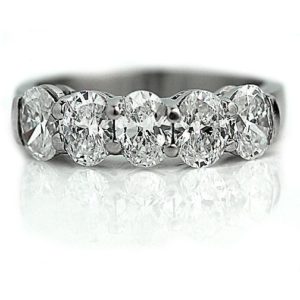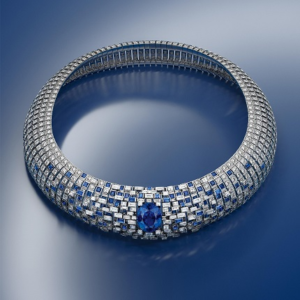
Moissanite vs Diamond: What’s the Difference?
[ad_1]

If you are looking for a diamond alternative for your engagement ring, your options are many. Gone are the days when you would need to search high and low for an affordable option or settle for no stone at all. Both technology and styles have evolved to make selecting a stone for an engagement ring more affordable and more personal.
Among the many options, a moissanite gemstone is a chemically unique, stunningly brilliant, and budget-friendly stone that many brides love. If you are interested in this gemstone for your engagement ring, you can learn everything you need to know about it right here. Consider this your complete guide to moissanite vs. diamond. Two distinct stones with incredible potential.
What is a Natural Diamond?
A natural diamond may as well be the 8th wonder of the world. Only after years and years spent miles beneath the earth’s surface, where extreme pressure and temperature react with carbon minerals, are natural diamonds formed. And only after a volcano erupts, are they brought to the surface and able to be discovered, on rare occurrences might we add, by miners. The raw diamonds that are mined are then cut by skilled diamond cutters into the beautiful stones used for diamond jewelry.
Natural Diamond Alternatives
It’s no secret that the demand for diamonds is high, and thus, the price is high. The price is also high due to all the labor and resources that go into getting that diamond from the earth to the jewelry display case.
For this reason, and many more, many people look for an alternative to the traditionally mined diamond.
What is a Simulated Diamond?
For ages, the fire and brilliance of a natural diamond have been coveted by many. Of course, given the incredible demand for this precious stone, it comes at an incredible cost. To counter the cost and still achieve the beauty of a natural diamond, creators simulate diamond stones.
A simulated diamond or diamond simulant, like the Nexus Diamond™ alternative, is a stone that is made to look like a natural diamond but has a slightly different chemical makeup.
What is a Lab Diamond?
Similar to simulated diamonds, lab diamonds are grown in a controlled environment in a lab. Unsimilar to simulated diamonds, though, lab diamonds have an identical chemical makeup to natural diamonds. That is, they are made of carbon that is exposed to extreme pressures and temperatures. The lab process is meant to mimic that of the process a natural diamond undergoes beneath the earth’s surface.
What is a Moissanite Diamond?
For starters, moissanite isn’t a diamond at all. It’s an entirely different, natural precious stone. Like diamonds, it’s formed in the earth. Unlike diamonds, it is made from silicon carbide. French scientist, Henri Moissan, first discovered moissanite in 1893 in a meteorite crater, giving it the nickname, “gemstone from the stars.”
Additionally, natural moissanite is incredibly rare. When it does appear in nature, it is as tiny crystals that are far too small to cut stones large enough for jewelry. Because of this, it is often created in a lab.
Similar to a lab created diamond, a lab created moissanite stone is chemically identical to its natural counterpart, but far more affordable. Although it has its own chemical makeup, moissanite is often confused with diamond because it can also be white in color and sparkle beautifully. This, plus its incredible affordability, is what has popularized moissanite for engagement rings and other fancy jewelry.
Moissanite vs Diamond Stones
While lab diamonds and simulated diamonds are also great alternatives to diamonds, here we’re focusing on how moissanite stones compare to diamonds.
In this moissanite vs diamond side-by-side comparison guide, you’ll learn the key differences that set these two precious gemstones apart so you can better decide which stone is right for you.
Chemistry
As we mentioned above, diamond and moissanite are made from two different minerals. Diamond is made up of carbon, while moissanite is made up of silicon carbide. These two minerals have different properties that affect the stone’s color, brilliance, and durability.
Sparkle
The difference in chemistry causes a difference in appearance, mainly as it relates to sparkle. Moissanite stones are doubly refractive, unlike diamonds which are singly refractive. To the non-gemologist, this means moissanite sparkles much more than diamond, but it also sparkles in a much different way. While the light a diamond reflects appears white, the light a moissanite gem reflects appears colorful. This fiery, brilliant, rainbow sparkle can sometimes make moissanite appear as a fake diamond. However, if you stick to smaller stones, the dramatic “fake” effect is less noticeable.
Color
While the most commonly used diamonds are colorless or near colorless in nature, they do come in a variety of fancy colors including pink, yellow, blue, and brown. Moissanite, however, can only be colorless, near colorless, or yellow-green in color.
For those looking for a colorless or near colorless gemstone, this distinction makes no difference. While at one time moissanite always had a yellow or green tint, colorless moissanite is the most common among modern lab-grown versions.
Durability
The hardness of a diamond is one of the reasons it’s sought after. The stone is durable enough to last a lifetime. In this way, diamond and moissanite are quite alike. On the Mohs scale of hardness, which rates precious gemstones on a scale of 1 to 10, diamond is rated at a 10 out of 10 and moissanite is rated at a 9.25-9.5. Moissanite is almost as hard as diamond, and will definitely stand the test of time.
Affordability
The most noticeable and beneficial difference for those who opt for moissanite over diamond is the cost. A moissanite stone and diamond of the same size and quality will be dramatically different in price; the moissanite stone being around a tenth of the cost of the diamond.
This dramatic difference in cost is due to the difference in labor and other resources required to mine a natural diamond compared to those required to create a moissanite stone in a lab. This isn’t only good for your pocket, though, it also benefits the earth. A lab-grown moissanite stone is a much more eco-friendly and sustainable option.
Moissanite vs Diamond Engagement Rings
There is an incredible amount of engagement rings to choose from so you can be sure you will find a style and stone that you will love forever. Whether you opt for a diamond engagement ring or a moissanite engagement ring, the quality of the stone is incredibly important. Pay special attention to the cut, color, clarity, and carat weight to find a quality stone that will emit beautiful brilliance and last a lifetime.
Carat
A moissanite stone can be a beautiful choice for an engagement ring, especially if you’re looking for maximum sparkle. To some, there is such a thing as “too much sparkle”, which can occur in a moissanite stone of large carat weight. If you’re after a stone that is larger than 1.5 carats and don’t fancy the intense shine of your moissanite ring, a diamond may be a better choice. However, if you’re not trying to pass your moissanite stone off as a diamond, then you can surely consider greater carat sizes. Understand the true physical size of different diamond shapes and their carat weights with our diamond carat size chart.
Clarity
When selecting a diamond for a diamond ring, choosing a stone that is “eye clean” is the rule of thumb, meaning there are no visible inclusions when the stone is viewed with the naked eye. This same rule applies when choosing a moissanite stone, especially because you can get incredible value for your money with moissanite compared to a diamond.
Which One Should I Choose?
Diamond and moissanite are different. While moissanite can be a wonderful diamond alternative for those seeking a more affordable option, it does vary in appearance. If you want the look of a true diamond for a lower price, you are better off selecting a diamond simulant.
However, if you want a stone with incredible sparkle at an incredible price, and you love the look of moissanite, moissanite could be right for you. Moissanite is a beautiful stone all on its own and looks incredible in any engagement ring setting.
When it comes time to decide between diamond and moissanite for your engagement ring, only you can make the right call. Don’t be swayed by pressure from peers, but choose the stone and setting that suit your life and style.
Sources:
Diamond Nexus
Gem Society
Brides
*Here at Diamond Nexus, we strive to provide valuable information while being clear and honest about our products. The Nexus Diamond™ alternative is a patented lab created diamond simulate that, among all simulants, most closely imitates the look, weight and wear of a diamond, with two exceptions – it is absolutely perfect in every way, and it costs significantly less. Price points and environmental facts expressed in this blog were taken from popular online retailers and may vary. Learn more about the environmental impact of mining by visiting our blog.
[ad_2]
Source link

